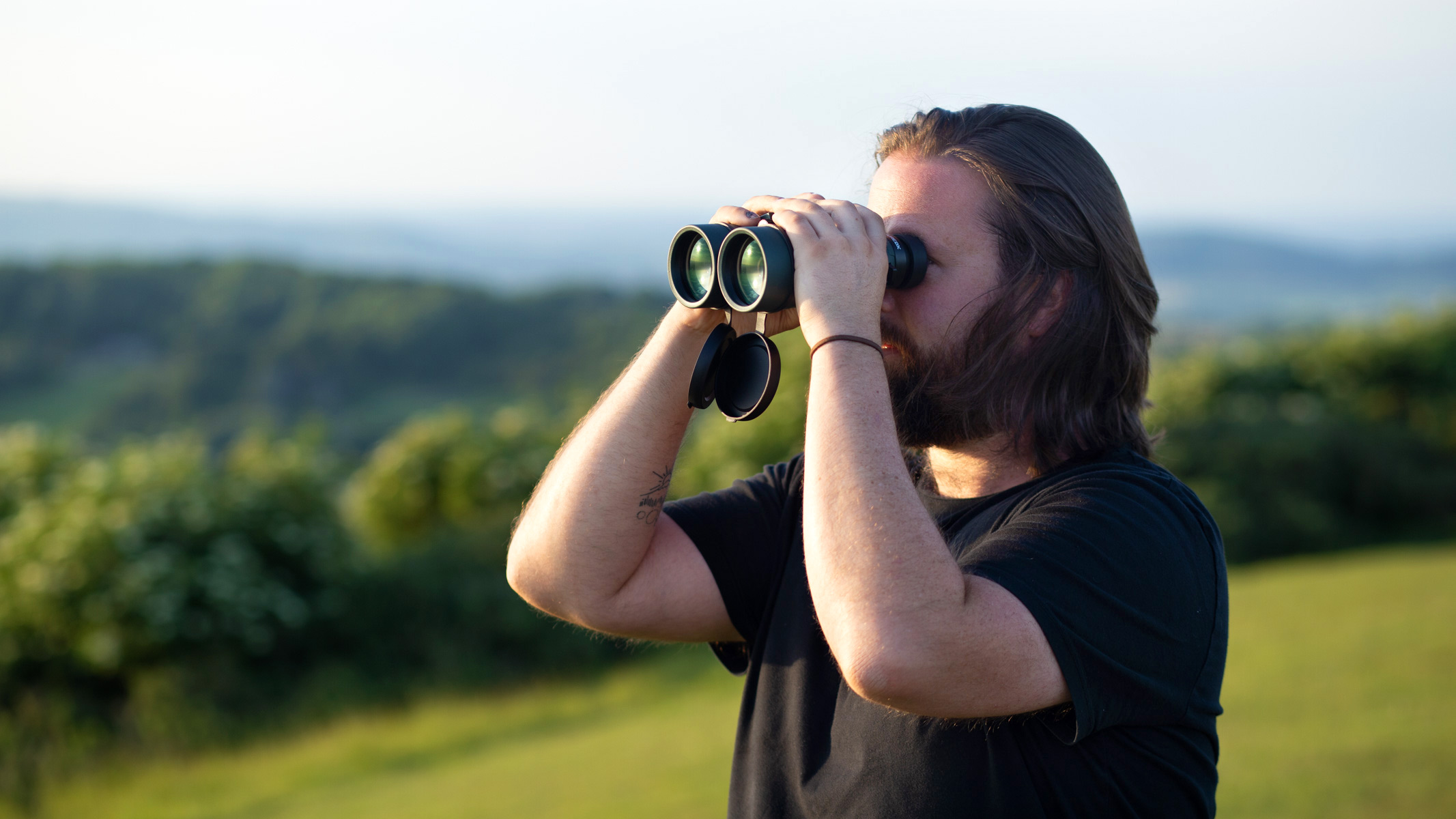Are you ready to take your bird watching, stargazing and wildlife observation to a whole new level? You can if you get the best travel binoculars of 2023!
With high powered lenses and quality components, these binoculars will ensure you get the clearest views. So let’s get started on your journey for the perfect pair of travel binoculars!
Best travel binoculars 2023
- Occer travel binoculars(Editor’s Pick)
- POLDR travel binoculars(Best Overall)
- Anourney travel binoculars(Budget Friendly)
- Generic travel binoculars
- Nikon travel binoculars
- Virtual travel binoculars
- Pentax travel binoculars
1)Occer Travel Binoculars
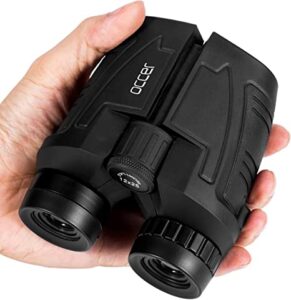
Occer Travel Binoculars are a reliable and durable choice for any outdoor enthusiast. With a 25-millimeter objective lens diameter and a 12x magnification maximum, these binoculars provide exceptional clarity and range.
The product dimensions of 3.93 x 4.3 x 1 inches make these binoculars compact and easy to carry. Weighing in at 13.7 ounces, they are relatively lightweight, making them a suitable option for long hikes and other outdoor activities.
The design of these binoculars is also quite sleek and lightweight, making them easy to pack and carry on trips. Overall, the Occer Travel Binoculars are a solid choice for anyone looking for a portable and powerful set of binoculars for their travels.
Pros:
- 25-millimeter objective lens diameter
- 12x magnification maximum
- Compact size (3.93 x 4.3 x 1 inches)
- Lightweight (13.7 ounces)
- Durable and reliable
Core feature
| Brand | Occer |
| Special Feature | Binocular |
| Objective Lens Diameter | 25 Millimeters |
| Magnification Maximum | 12 x |
| Product Dimensions | 3.93 x 4.3 x 1 inches |
| Item Weight | 13.7 ounces |
2)POLDR Travel Binoculars
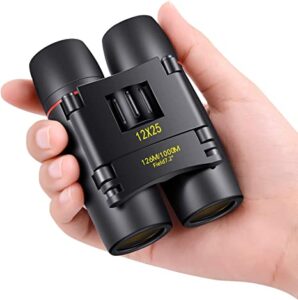
POLDR Travel Binoculars are perfect for those who want a compact and lightweight option without sacrificing quality. With a 25-millimeter objective lens diameter and a 12x magnification maximum, these binoculars provide outstanding performance. The eye relief of 16 millimeters adds to their overall comfort.
The black color and compact size (4.37 x 3.14 x 2.09 inches) make them sleek and portable. At just 6.7 ounces, they are also one of the lightest options available. The lightweight design makes them easy to carry around, so you won’t feel weighed down during long hikes or outdoor activities.
Whether you’re hiking, camping, or birdwatching, the POLDR travel binoculars are a reliable and functional option for all your outdoor adventures. Overall, if you’re looking for a pair of binoculars that are lightweight, compact, and provide clear images, the POLDR travel binoculars are definitely worth considering.
Pros:
- Compact and lightweight option desired quality
- 12x magnification maximum
- 16-millimeter eye relief
- Compact size (4.37 x 3.14 x 2.09 inches)
- Lightweight (6.7 ounces)
Core feature
| Brand | POLDR |
| Objective Lens Diameter | 25 Millimeters |
| Magnification Maximum | 12 x |
| Color | Black |
| Size Map | Compact |
| Eye Relief | 16 Millimeters |
| Package Dimensions | 4.37 x 3.14 x 2.09 inches |
| Item Weight | 6.7 ounces |
3)Anourney Travel Binoculars

Anourney Travel Binoculars offer a unique combination of performance and style. With a 21-millimeter objective lens diameter and an 8x magnification maximum, these binoculars are perfect for casual use. The rubber material adds durability and grip, while the available colors (blue and green) add a touch of personalization.
The eye relief of 21 months ensures comfort during extended use. The compact dimensions (4 x 2 x 2 inches) make these binoculars easy to carry. This feature is especially important for long hikes or trips where every ounce counts. Furthermore, these binoculars provide a clear and bright image, even in low light conditions.
This is thanks to their high-quality lenses that are coated to reduce glare and improve contrast. Overall, the Anourney Travel Binoculars are an excellent option for travelers and nature enthusiasts looking for a reliable and compact pair of binoculars that deliver clear and sharp imaging. Their lightweight and foldable design make them a practical choice for those on the go.
Pros:
- 21-millimeter objective lens diameter
- 8x magnification maximum
- Durable rubber material
- Available in blue and green
- Compact dimensions (4 x 2 x 2 inches)
Core feature
| Brand | Anourney |
| Objective Lens Diameter | 21 Millimeters |
| Magnification Maximum | 8 |
| Color | Blue,Green |
| Material | Rubber |
| Eye Relief | 21 months |
| Item Dimensions LxWxH | 4 x 2 x 2 inches |
4)Generic Travel Binoculars (NEOVIC)
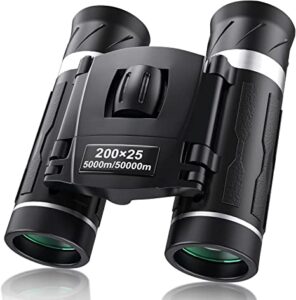
NEOVIC Generic Travel Binoculars offer a quality experience without breaking the bank. With a 25-millimeter objective lens diameter, these binoculars provide excellent clarity. The fully multi-coated lens coating ensures optimal light transmission and reduced glare. The compact size (3 x 2.5 x 2 inches) and lightweight design (6.4 ounces) make these binoculars easy to transport. The available colors (blue and green) and the combination of glass and rubber materials add durability and style.
The materials used in manufacturing these binoculars are safe for the environment, ensuring that you don’t harm the planet while enjoying the beauty of nature. Overall, the generic travel binoculars are an excellent investment for anyone looking for a lightweight, portable, and eco-friendly option for their outdoor adventures. With their anti-reflective lens and compact design, these binoculars provide a clear and enjoyable viewing experience, while also being kind to the environment.
Pros:
- 25-millimeter objective lens diameter
- Fully multi-coated lens coating
- Compact size (3 x 2.5 x 2 inches)
- Lightweight (6.4 ounces)
- Available in blue and green
Core feature
| Brand | NEOVIC |
| Objective Lens Diameter | 25 Millimeters |
| Color | Blue,Green |
| Material | Glass, Rubber |
| Size Map | Compact |
| Lens Coating Description | Fully Multi-Coated |
| Package Dimensions | 3 x 2.5 x 2 inches |
| Item Weight | 6.4 ounces |
5)Nikon Travel Binoculars
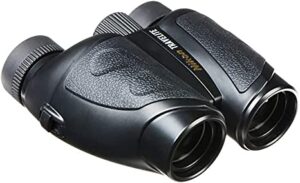
Nikon Travel Binoculars offer a high-quality option from a well-known brand. With a 25-millimeter objective lens diameter and a 10x magnification maximum, these binoculars provide great performance. The plastic material ensures durability without adding unnecessary weight (9.8 ounces).
The sleek black color and product dimensions (7 x 5.7 x 2.77 inches)make these binoculars both stylish and easy to carry. Nikon’s reputation for quality optics guarantees a satisfactory experience for users. This is particularly useful for birdwatchers and nature enthusiasts who want to observe small animals and insects up close.
Overall, the Nikon Travel Binoculars are an excellent investment for anyone who values quality, portability, and performance. With their multicoated lenses, Eco-Glass optics, and close focus distance, these binoculars offer a superior viewing experience that is hard to beat in this price range.
Pros:
- 25-millimeter objective lens diameter
- 10x magnification maximum
- Durable plastic material
- Compact dimensions (7 x 5.7 x 2.77 inches)
- Renowned brand for quality optics
Core feature
| Brand | Nikon |
| Objective Lens Diameter | 25 Millimeters |
| Magnification Maximum | 10 |
| Color | Black |
| Material | Plastic |
| Product Dimensions | 7 x 5.7 x 2.77 inches |
| Item Weight | 9.8 ounces |
6)Virtual Travel Binoculars
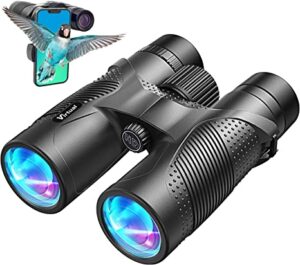
Virtual Travel Binoculars offer a powerful viewing experience for outdoor enthusiasts. With a 42-millimeter objective lens diameter and a 12x magnification maximum, these binoculars provide exceptional clarity and range. The black color and product dimensions of 6.2 x 5 x 2.4 inches make these binoculars sleek and portable. Although heavier than other options at 2.03 pounds, the superior performance may justify the added weight for some users.
What sets this device apart is its incredible vision. The binoculars offer a clear and crisp view, enabling users to spot wildlife, landmarks, and even constellations. It’s perfect for adventurers who want to explore different terrains without the hassle of carrying bulky equipment.
Overall, the Virtual Travel Binoculars are a must-have for any travel enthusiast. Its features make it user-friendly and versatile, and its incredible vision ensures a memorable experience.
Pros:
- 42-millimeter objective lens diameter
- 12x magnification maximum
- Sleek design and color
- Compact dimensions (6.2 x 5 x 2.4 inches)
- Exceptional performance
Core feature
| Brand | Virtual |
| Objective Lens Diameter | 42 Millimeters |
| Magnification Maximum | 12 |
| Color | Black |
| Product Dimensions | 6.2 x 5 x 2.4 inches |
| Item Weight | 2.03 pounds |
7)Pentax Travel Binoculars

Pentax Travel Binoculars are a compact and lightweight choice for those seeking quality optics. With an 8x magnification maximum, these binoculars provide a clear and steady view. The green color and unique material make them stand out from the competition. The eye relief of 21 adds to their overall comfort.
The compact size (1.6 x 4.1 x 4.34 inches) and lightweight design (9.6 ounces) make these binoculars easy to carry and store. The rubber armor coating provides a secure grip, even in wet or damp conditions, while protecting the binoculars from scratches and bumps. The multi-coated lenses deliver a clear and bright image, even in low light conditions.
These Pentax travel binoculars are an excellent choice for anyone looking for a reliable and high-quality pair of binoculars for their next adventure.
Pros:
- 8x magnification maximum
- Unique material and green color
- 21 eye relief
- Compact size (1.6 x 4.1 x 4.34 inches)
- Lightweight (9.6 ounces)
Core feature
| Brand | Pentax |
| Color | Green |
| Material | Other |
| Size Map | Compact |
| Eye Relief | 21 |
| Product Dimensions | 1.6 x 4.1 x 4.34 inches |
| Item Weight | 9.6 ounces |
Best travel binoculars 2023-Complete Buying Guide
Good binoculars should be an essential tool for any explorer. You can use them to observe nature, birds, and distant vistas from a unique view. They are also essential for concerts, sports events, and even surveillance. Before you make your purchase, you need to think about the type of activities you will be using them for.
For those who are looking to purchase the best travel binoculars in 2023, it is important that they decide on their desired features and pick the right product. It is also important to know what magnification power is right for your needs and what kind of budget one should have set aside for these purchases. Lastly, don’t forget that comfort must always be considered as a primary feature when choosing binoculars as prolonged use can otherwise cause eye strain if you’re not careful!
In this comprehensive guide we aim to analyze different kinds of binoculars available in the market and discuss which features are essential in choosing the best travel binoculars 2023 to suit your needs and specifications.
Explanation of the importance of having the right travel binoculars for a successful trip

Photo Source :csginger.com
Having the right pair of travel binoculars is important for enjoying a successful trip. When it comes to binoculars, size and weight really matter. Most people don’t carry heavy binoculars in their backpacks, which means you want your binoculars to be as light and compact as possible while still providing clear and sharp images. In addition, you also want to take into account the magnification range of the binoculars you pick, since this factor affects their performance in different environments.
The type of lens used is also important when selecting your ideal travel binoculars—to ensure that they can handle varied light and weather conditions. The coating on the lenses will determine how much and what type of reflection the lenses will produce when exposed to different levels of light—this will affect image quality significantly. It is also important that the prism in your travel binoculars is protected from moisture or extreme temperatures by using a waterproof/fogproof material like rubber or plastic that creates a seal over the prism, allowing you to use them in any environment without fear of damage or poor performance due to weather factors.
In summary, selecting a good pair of travel binoculars can be essential for enjoying your trip while still having an optimal image quality experience with everyday activities such as birdwatching or stargazing. Regardless of whether it’s day or night time!
Brief overview of the content that will be covered in the buying guide

Photo Source :scopeuout.co
In this buying guide, we will provide a comprehensive review of the best travel binoculars available on the market for 2023. We’ll cover aspects such as price, design, functionality and weight.
We’ll also look at the different types of binoculars, their size and magnification level, extra feature and accessories they come with and how they might compare to each other.
By looking through this buying guide you should be able to find the right pair of travel binoculars for you and your individual needs.
Factors to Consider Before Buying Travel Binoculars
Even though there’s no single pair of binoculars that can fit everyone’s needs, there are a few important factors to consider before deciding which pair is the best for you. This section outlines those factors so that you can make an informed decision when reviewing the remaining sections about different models of travel binoculars.
- Magnification: This refers to how powerful the lenses are and is typically written as two numbers separated by an “x” with one of them being 8 or 10. The first number refers to how much larger the image viewed through the binoculars will be compared to viewing from the naked eye. A magnification rating of 8x indicates that far away things will appear to be eight times closer than they actually are.
- Lens diameter: This refers to the size of each lens in millimeters and typically ranges from 20-70mm or more (the larger, the better). Larger lenses allow more light to enter which opens up several possibilities such as superior image quality in low-light environments or images with greater detail resolution at a distance.
- Field view: Field view is the angle that you can see through the binocular lenses, usually listed in degrees (a full 360º circle). A wider field view allows a user to take in more peripheral vision while tracking a distant object without having to move their eyes nearly as much in order track it across their field of vision. As far as travel optics go, anything above 8-9 degrees should suffice depending on preference.
- Exit pupil: The exit pupil determines how bright your image will appear when viewed through your binoculars and is calculated by dividing lens diameter by magnification rating (i.e., 8×40 = 5mm). While larger pupils generally produce brighter images, six millimeters is considered very good in most applications and five millimeters supports comfortable viewing with slight fatigue over time when used for extended periods during activities such as bird watching, star gazing or general sightseeing trips at home or abroad.
Magnification and Objective Lens Size
When shopping for binoculars, it’s helpful to be familiar with the two most important terms associated with optical performance: magnification and objective lens size.
Magnification is expressed as a ratio of x (example 8x or 10x). This is the number of times closer an object appears in the binocular than if viewed with the naked eye, and it will typically have a range from 7-20x. A higher magnification means that objects will appear bigger, but also dimmer than lower magnifications. For example, an 8×42 binoculars increases your field of view 8 times compared to without binoculars.
The second part of this equation is called the objective lens size expressed in millimeters (example: 42mm). This number indicates the diameter of the lenses at the leading edge of each optical piece. Generally speaking, larger objective lenses gather more light providing better image quality at dawn and dusk; however, they can also introduce more inevitable optical aberrations resulting in slightly less sharp images during daytime viewing. Ultimately, a higher total “combined” value like 10X42 or 12X50 would be better for low light since more light getting passed through with bigger lenses resulting from higher magnifications would balance out lower low-light performance caused by larger optical aberrations.
Field of View
The Field of View (FOV) of a binocular is another important factor to consider when shopping for a pair. FOV is measured by the width of the view at 1000 yards away and measured in feet. The larger the FOV, the wider the area you can see while looking through your binoculars. Wide angle lenses have greater FOV, making them a great choice for scanning large areas quickly or viewing fast-moving objects or wildlife.
Narrow angle lenses have less FOV and are most suitable for viewing stationary objects such as distant landscapes and bird watching. You will also find outside focus Field of View ratio numbers associated with some binoculars. This refers to how much you can see beyond your focus point and gives greater clarity when viewing objects close to each other or far away from each other at the same time.
Eye Relief
Eye relief is the distance between the eyepiece lens and your eye when you’re using binoculars. This distance is important when assessing what to look for in a pair of binoculars.
If you have glasses, then the eye relief should be long enough to ensure a full field of view with your corrective lenses on. For people without glasses, eye relief becomes less important unless they plan on using the binoculars at night or in low light conditions, where they will need to press the rubber eyecup against their face in order to block out ambient light.
Generally speaking, longer eye relief allows for more comfortable viewing over long periods of time by providing more space between your eyelashes and the eyepiece. When shopping for binoculars, look for models that provide 10-14mm of eye relief that are well suited to long viewing sessions, regardless of whether you wear glasses or not.
Types of Binoculars for Travel
When it comes to selecting the best travel binoculars for your destination, it is important to consider the different types that are available. Depending on where you are headed, some binoculars will be more suitable than others. Some travelers may prefer to bring just one type of travel binocular for all their activities, while others may choose to bring several options depending on where and how far they plan to travel. Below is an overview of the various types of binoculars available for travel.
Compact Binoculars – Compact binoculars are perfect for travelers who want something small and lightweight that can be easily tucked into a pocket or purse. These typically provide 8x magnification, making them ideal for short-range observations such as spotting birds or watching animals in the wild. They often come with eyecups that help protect eyes from wind and sun-glare and have durable rubber armor construction with non-slip grip surfaces.
Mid-Size Binoculars – Mid-sized binoculars provide higher magnifications (8x – 10x) than compact models, and they also typically offer larger lenses that absorb more light than smaller lenses allowing sharper images at a distance. These will often come with adjustable eyecups which accommodate both near and far vision as well as long eye relief (the distance from lens to inner eye) making them ideal for those wearing glasses when looking through them.
Full-Size Binoculars – For distances over 500 yards, full size binoculars provide excellent image quality thanks to their extra large lenses which maximizes light absorption leading to brighter images and greater detail recognition in low light conditions. They also identify greater object details at greater distances than mid-size models due to their higher magnifications (upwards of 15X). These typically offer larger exit pupils making easier viewing without blackouts or streaking when panning across landscapes or scanning vast areas over time due to improved image stabilizing qualities inside large housing designs with multiple anti-glare coatings over high quality coated optics lens surfaces.
Compact Binoculars
Compact binoculars are ideal for travelers, as they are extremely lightweight and small enough to slip into a pocket or bag. A pair of compact binoculars is usually less powerful than its full-size counterparts, with magnification typically only 8x or 10x. However, they are far more convenient to carry around during long days of travel and treks through wild terrain. Compact binoculars that can fit in the palm of your hand are capable of capturing quite distant details while still allowing a wide field of view due to the lower magnification. The trade-off is sacrificing image clarity compared to higher magnifications.
High quality lenses reduce chromatic aberration and ghosting for sharp images even at low magnifications. Additionally, some models come with coatings that help deflect water and moisture in wet environments, making them perfect for outdoor adventures. Furthermore, many brands have incorporated shock-proof rubberized coatings which makes them even more travel friendly and robust against any knocks and bumps that come with active outdoor trips!
Full-Size Binoculars
Full-size binoculars with objective lens sizes of over 42mm offer the largest light gathering capabilities to deliver clear, bright images in low-light situations. Binoculars with larger objective lenses also have a wide field of view and greater depth of field to see details and landscapes in great clarity. Additionally, full-size binoculars tend to have better resolution than compact binoculars and provide sharper images.
Full-size binoculars have traditionally been the heaviest design, but modern materials and superior engineering has enabled manufacturers to reduce their weight without compromising strength or optics. Typically, the only drawback of full-size binoculars is the increased size which can make them difficult to carry in a pocket or small bag. If you need maximum image performance for demanding conditions, then full-size models are an ideal choice for your outdoor adventures.
Zoom Binoculars
Zoom binoculars are great for travelers who want to enhance their sight whether watching wildlife, stunning views, or distant activities. They are incredibly versatile, allowing you to magnify images for closer observation with the same mobility desired of compact binoculars. They have a wide range of magnification capabilities from 8x – 30x and usually feature low dispersion glass lenses with advanced phase/dielectric coatings for brilliant clarity and color representation.
Many include rubber armorings and specialized ergonomic designs which provide a secure grip during usage or transportation in the field. Furthermore, they may offer engravings indicating the magnification strength, feature “twist up” eye cups suited for the comfort of those with glasses or contact lenses and encapsulated optical elements that prevent dust and moisture entering the internals of the instrument.
With so many models on the market, it can be difficult to find what’s worth investing in so we’ve put together this comprehensive buyer guide to help you make an informed decision when purchasing your zoom binoculars in 2023.
Conclusion
When it comes to choosing the best binoculars for travel, there are several factors to consider. A good pair of binoculars should be lightweight and compact, have a wide field of view, good low light performance and a high level of optical clarity. These features can add up to make a big difference in your viewing experience.
In addition, it’s important to make sure you buy a pair that is waterproof and resistant to shock since they will likely be subject to different weather conditions while on the road.
Finally, price is an important factor when shopping for travel binoculars – you’ll want to find something within your budget that also meets all your needs. With this guide, we hope you’re better equipped to choose the perfect binoculars for your next adventure!
FAQ’s
Which is better 10×42 or 20×50 binoculars?
It depends on your intended use. If you want higher magnification and don’t mind sacrificing some brightness and field of view, then the 20×50 binoculars may be better. But if you prioritize brightness and wider field of view, then the 10×42 binoculars may be the better choice.
What binoculars do the military use?
The military uses a variety of binoculars depending on the specific application, but some common models include the Steiner Military/Marine binoculars, the Vortex Fury HD binoculars, and the Leica Geovid HD-B binoculars.
What are the tourist binoculars called?
Tourist binoculars are often called “coin-operated binoculars” or “viewing scopes.”
Which is the best binoculars?
Some popular binocular brands include Nikon, Canon, and Bushnell. The best binoculars for you will depend on your specific needs and budget.
Which is better 10×50 or 20×50 binoculars?
Again, it depends on your intended use. If you want higher magnification and don’t mind sacrificing some brightness and field of view, then the 20×50 binoculars may be better. But if you prioritize brightness and wider field of view, then the 10×50 binoculars may be the better choice.
What is the maximum range of binoculars?
The maximum range of binoculars varies widely depending on the specific model and conditions. In general, most binoculars have a maximum range of several miles, but this can be affected by factors such as weather, terrain, and the size of the object you are trying to observe.
How far can you see with 12×50 binoculars?
The distance you can see with 12×50 binoculars depends on the specific model and conditions. In general, you can see objects several miles away with 12×50 binoculars, but this can be affected by factors such as weather, terrain, and the size of the object.
How far can military binoculars see?
The range of military binoculars varies widely depending on the specific model and purpose. Some military binoculars can see objects up to several miles away, while others are designed for use in low-light or night-time conditions.
How do I buy good binoculars?
To buy good binoculars, consider factors such as the intended use, magnification, objective lens size, image quality, and durability. Research different models and brands, read reviews, and try out different binoculars in person if possible before making a purchase.
What are the best binoculars money can buy?
The best binoculars for you will depend on your specific needs and budget. Some high-end binocular brands include Swarovski, Zeiss, and Leica, but there are also many excellent binoculars available at lower price points from brands such as Nikon, Canon, and Vortex.
